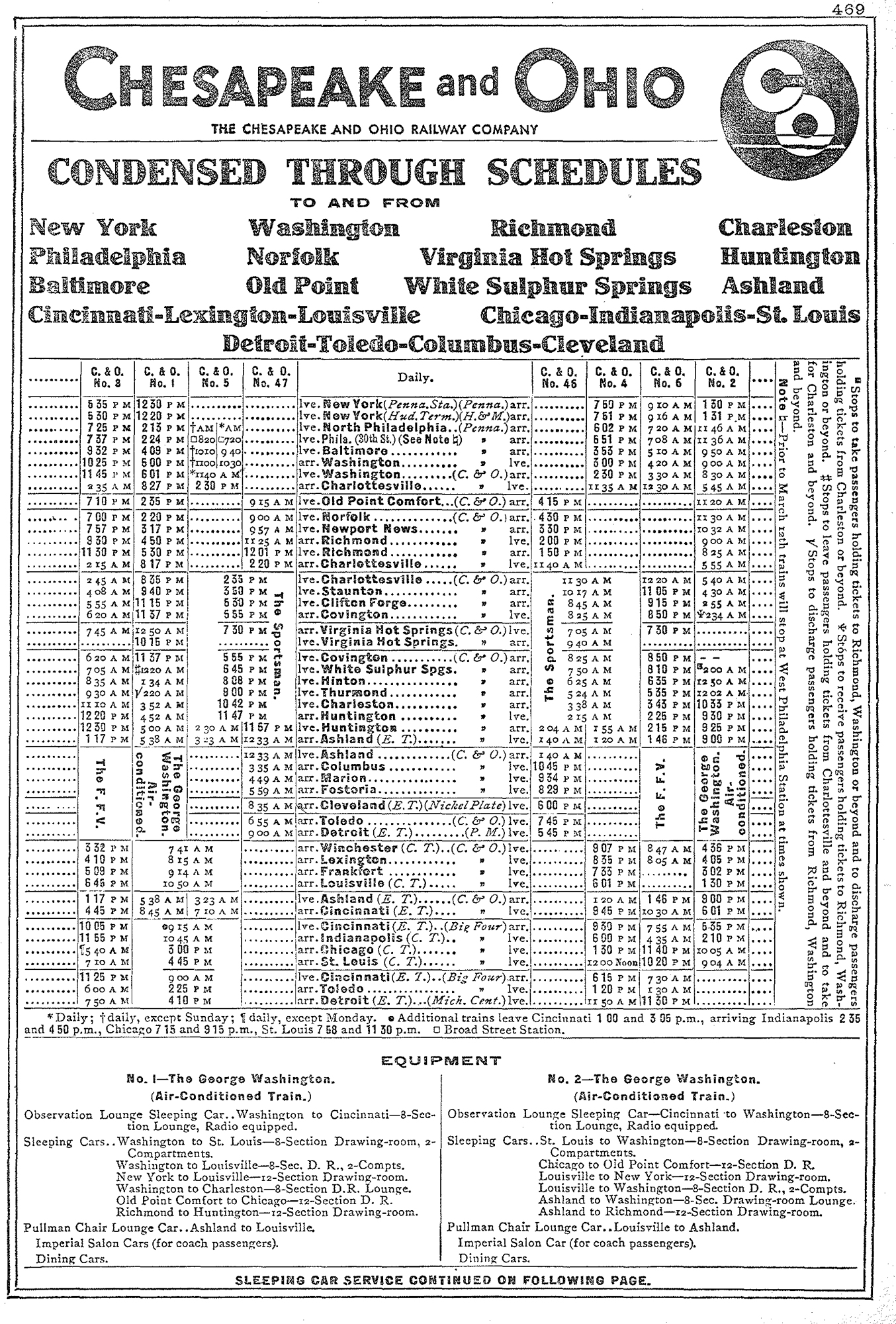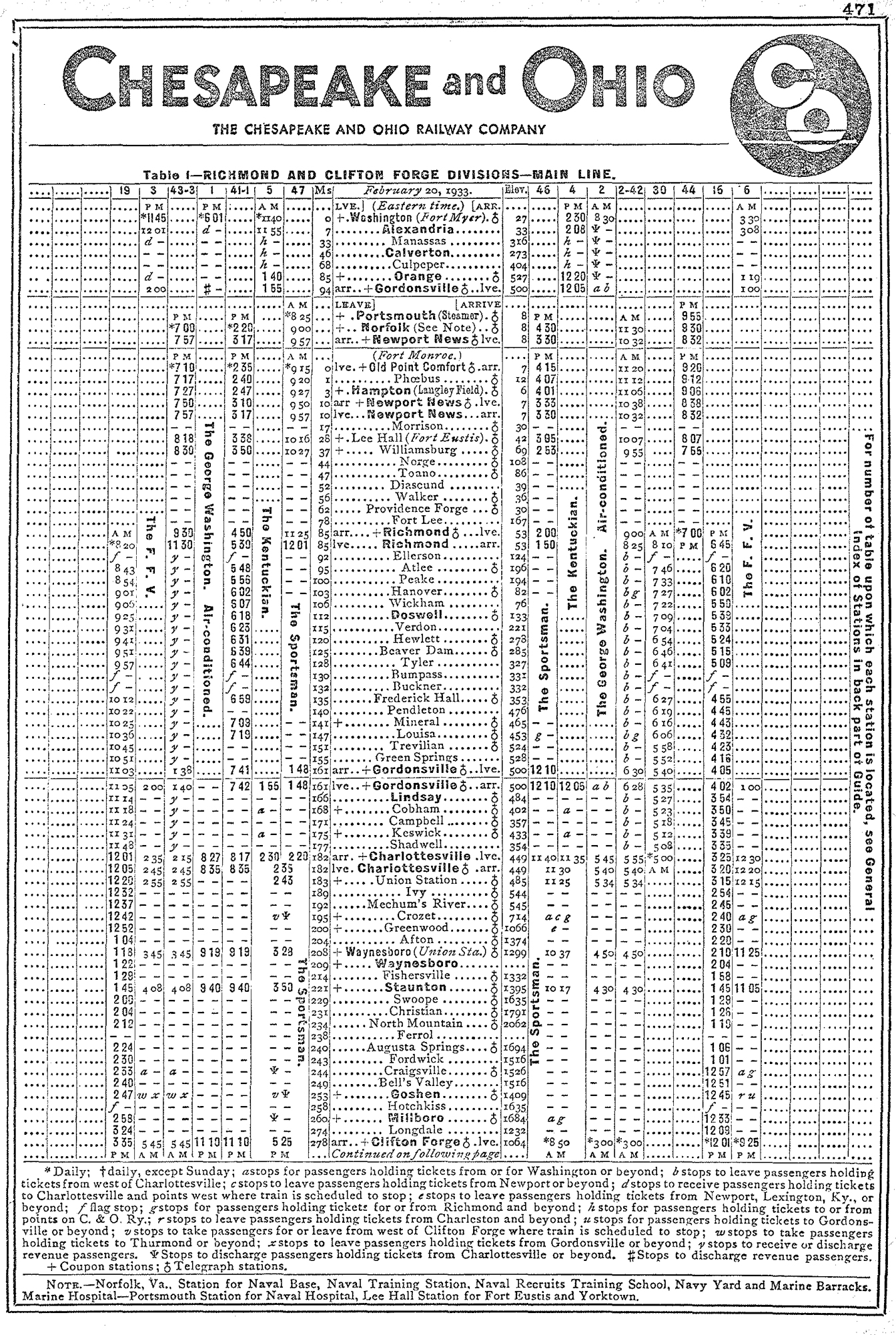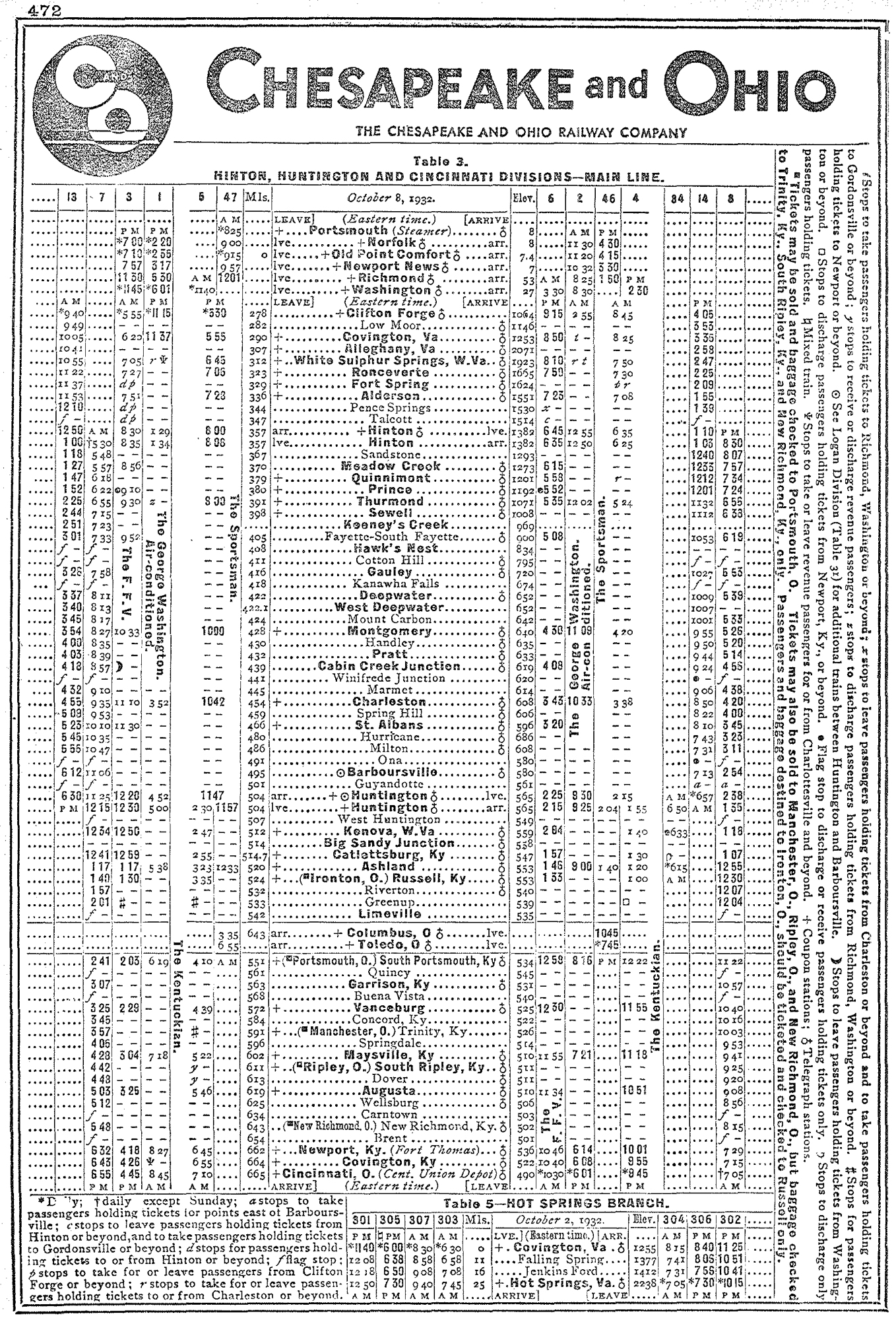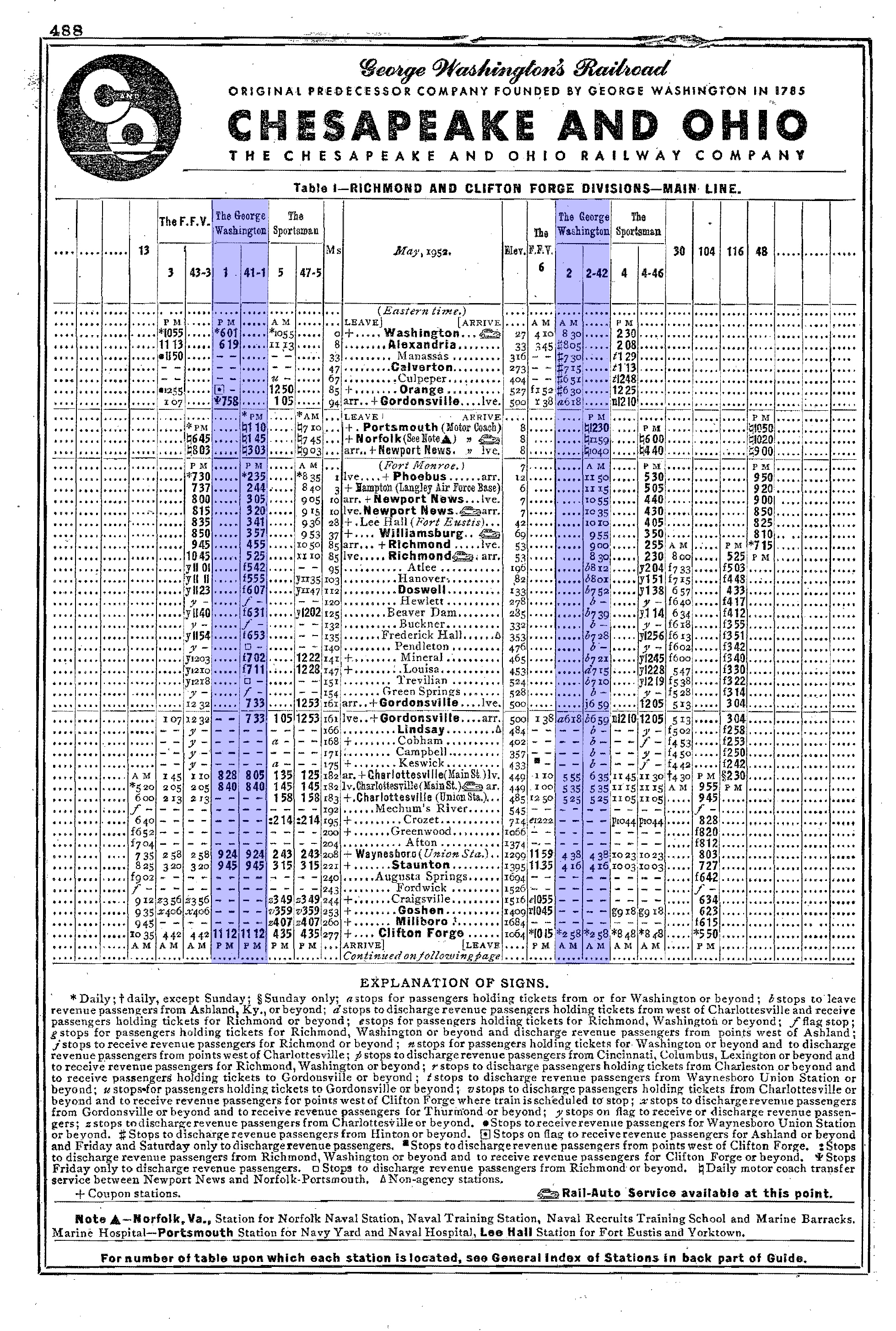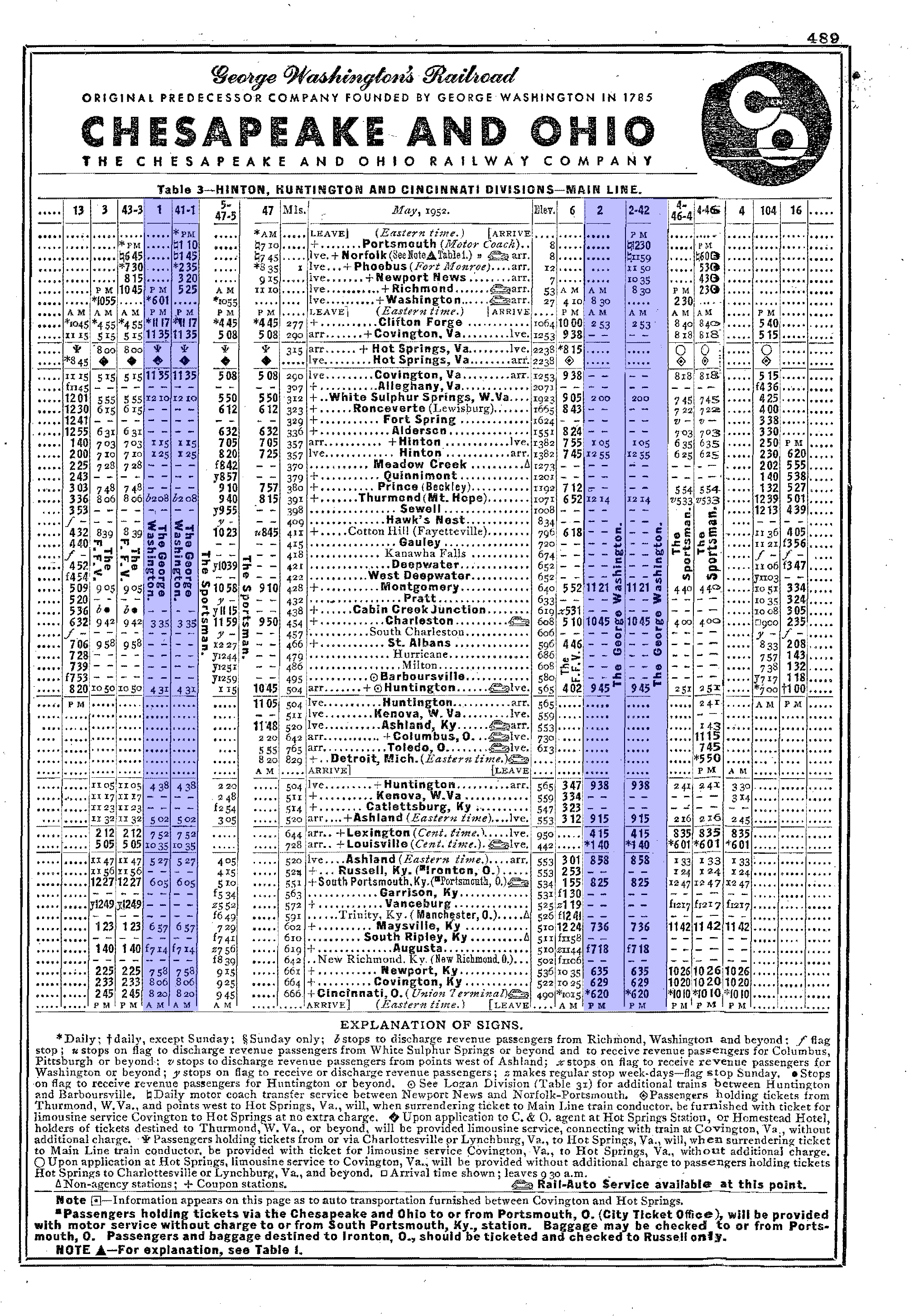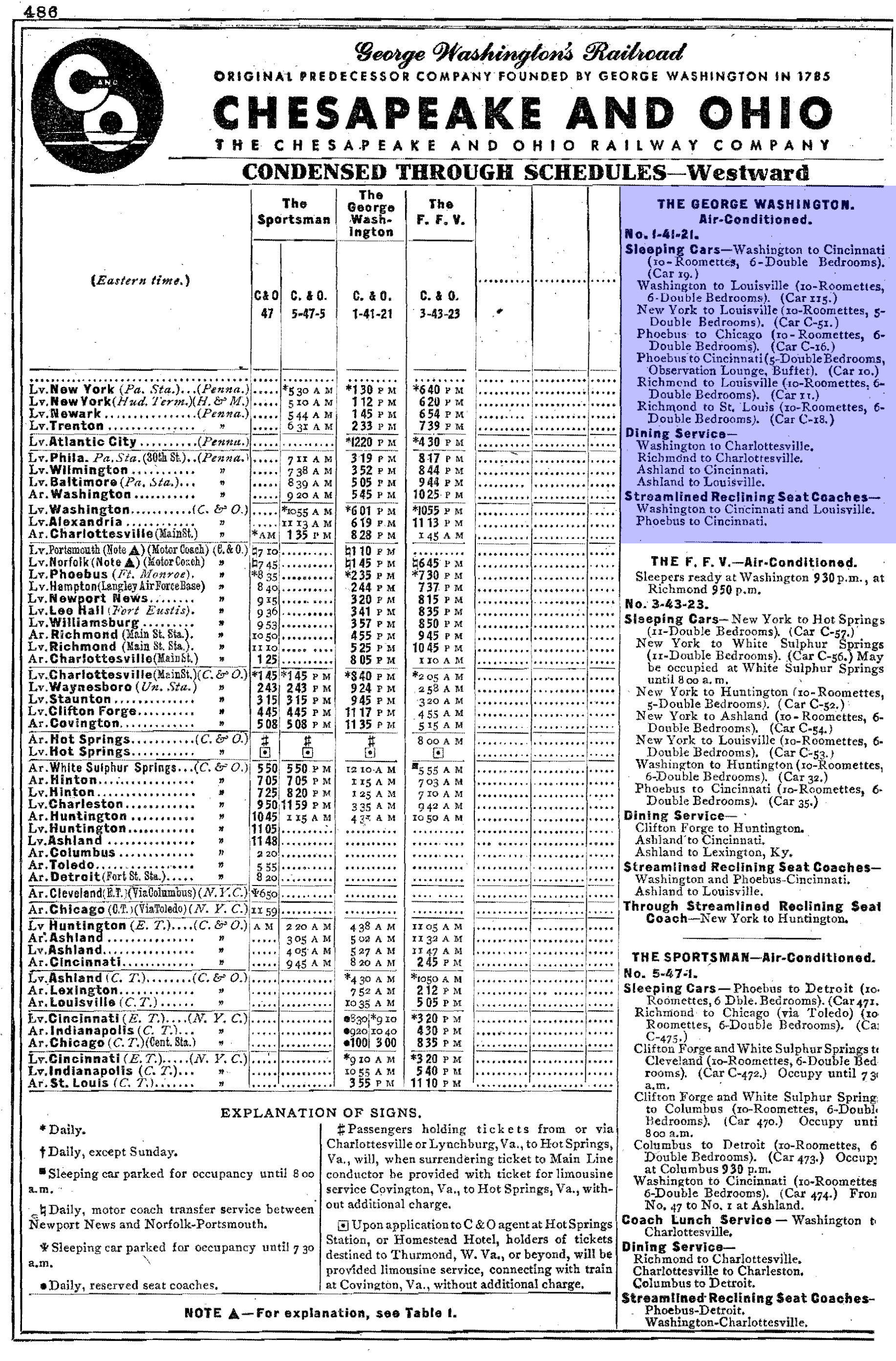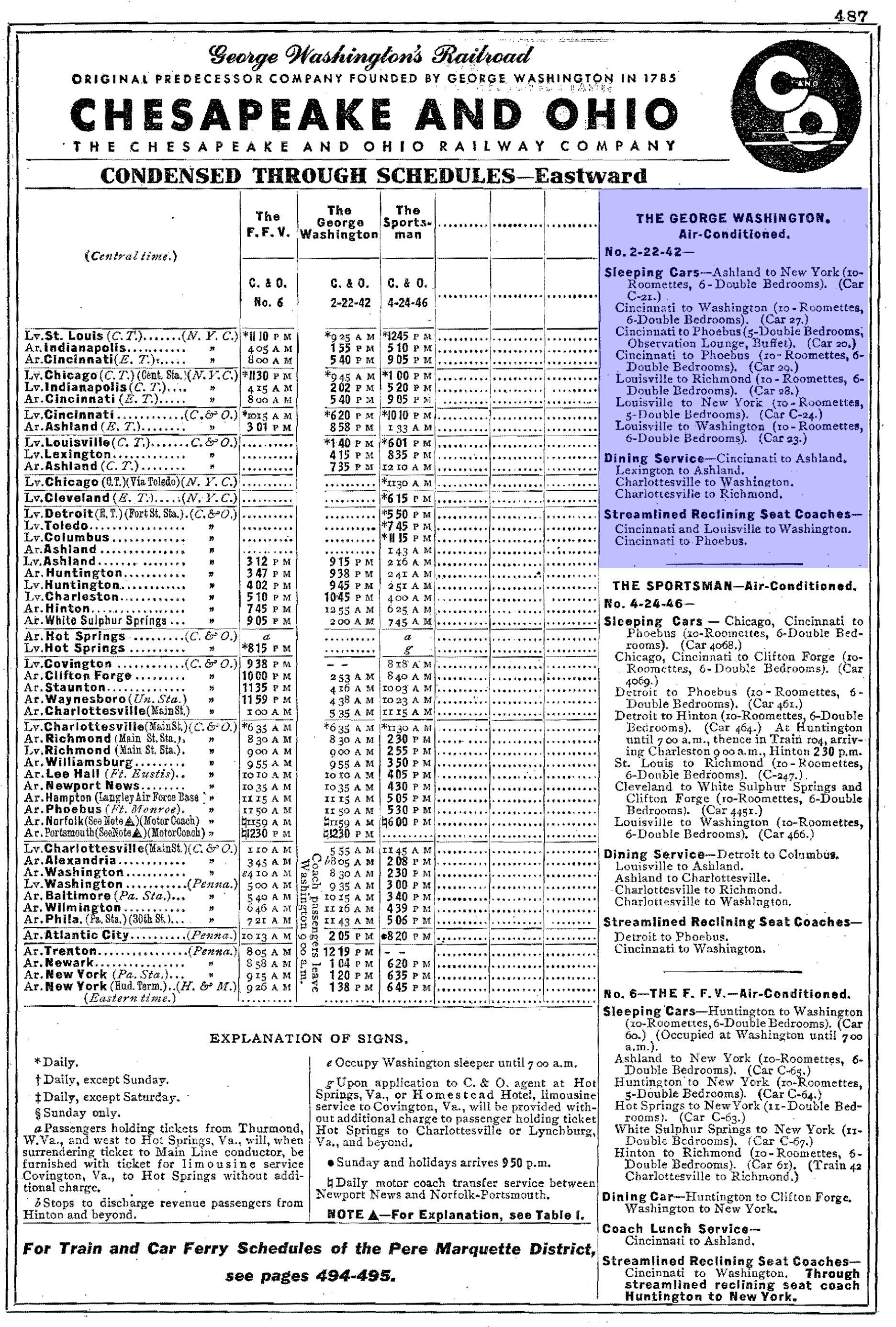C&O's "George Washington" (Train): Timetable, Route, Consist
Last revised: February 27, 2025
By: Adam Burns
The George Washington joined the C&O's timetable in 1932, marking the bicentennial of George Washington's birth. The railroad spared no expense launching this deluxe, heavyweight train, which featured an array of new and improved accommodations.
The train quickly eclipsed its counterparts - the Sportsman and Fast Flying Virginian - as the railroad's premier first class service. Initially, the C&O had little interest in the streamlined movement.
However, that changed under new president Robert Young, who strongly believed in the concept and passenger service in general. During - and immediately after - World War II he devoted millions to new lightweight equipment from Budd and Pullman-Standard, and also attempted to launch a new steam-turbine powered streamliner, The Chessie.
As Thomas Dixon, Jr. notes in his book, "Chesapeake & Ohio Passenger Service: 1847-1971," Young even boasted his Pullman order was the "largest ever" from an individual builder.
Unfortunately, with waning interest in postwar rail travel, coupled with the steam turbine's issues, a considerable portion of Young's order was ultimately sold off. However, the C&O did go on to acquire 130 new lightweight coaches, sleepers, parlors, lounges, and diners.
While the train's name is but a memory part of the route it followed is still used by Amtrak's Cardinal today between Washington and Chicago.
Photos
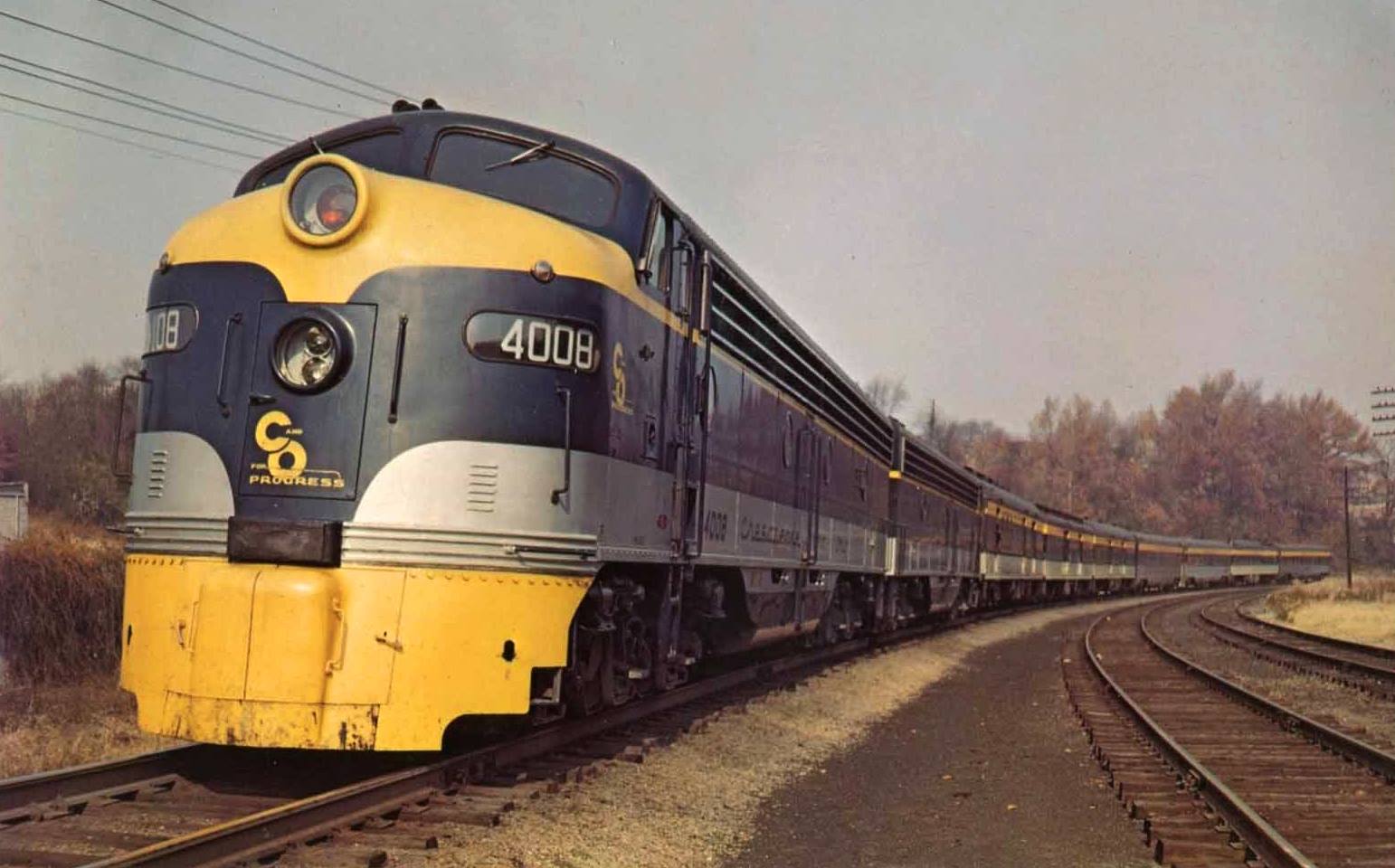 A Chesapeake & Ohio publicity photo of the newly streamlined "George Washington" (Washington/Newport News - Cincinnati/Louisville) seen here during the early 1950s.
A Chesapeake & Ohio publicity photo of the newly streamlined "George Washington" (Washington/Newport News - Cincinnati/Louisville) seen here during the early 1950s.History
The C&O's modest passenger fleet is somewhat ironic considering it launched the most beloved and successful PR campaign of any railroad, Chessie the kitten, in 1933.
The mascot was used extensively for marketing purposes and is still widely recognized today. The C&O was even working to launch a streamliner by that name during the 1940s but ultimately gave up on the idea.
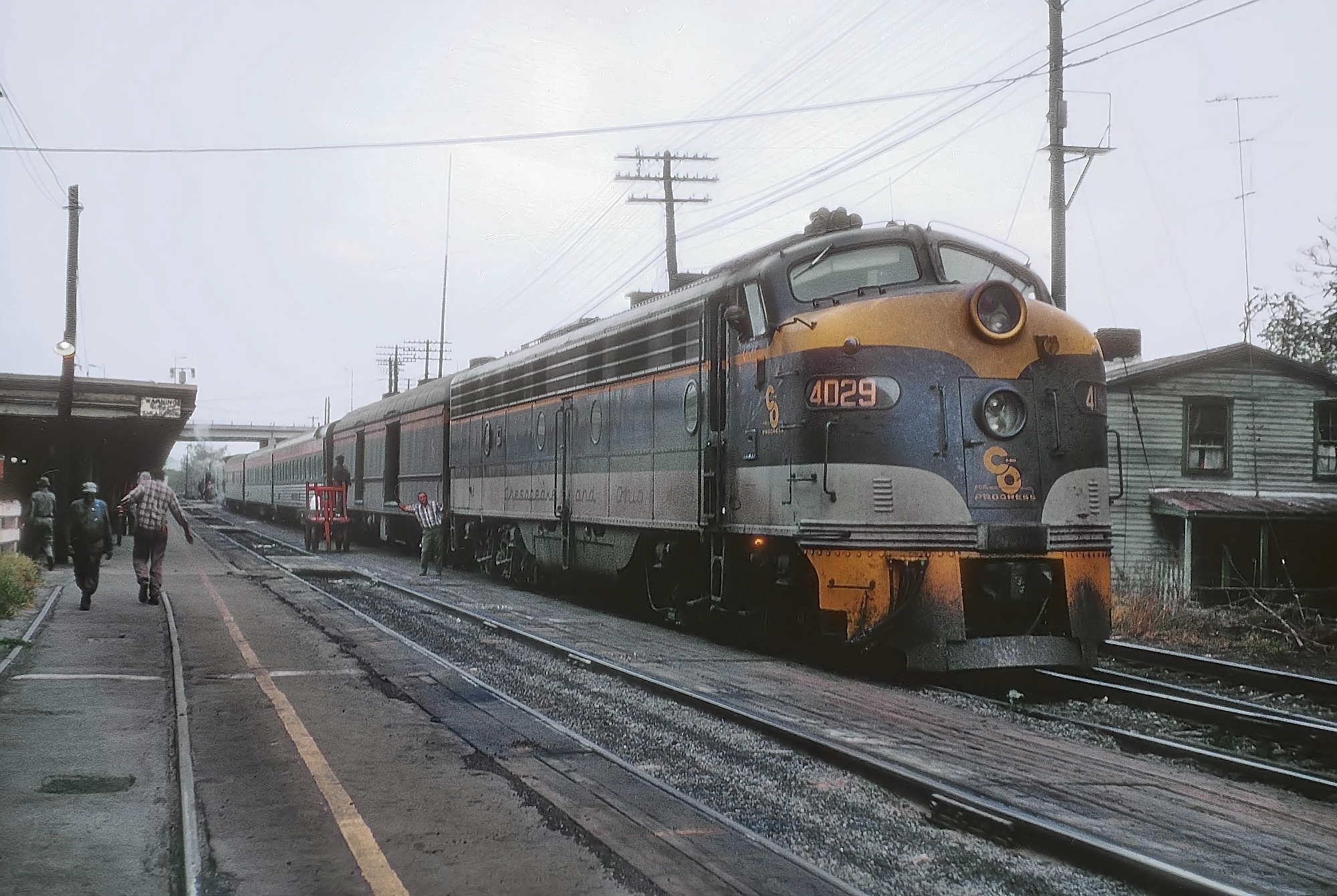 Chesapeake & Ohio E8A #4029 is ahead of train #41, the "George Washington" stopped at Charlottesville, Virginia in October, 1968. Rick Burn photo.
Chesapeake & Ohio E8A #4029 is ahead of train #41, the "George Washington" stopped at Charlottesville, Virginia in October, 1968. Rick Burn photo.Inauguration
The George Washington was inaugurated on April 30, 1932 in conjunction with the real George Washington’s birth year, which had occurred 200 years earlier (but not on the same day), operating between Newport News and Cincinnati, with through sleepers provided as far as New York City and St. Louis.
Interestingly, as Mike Schafer and Joe Welsh note in their book "Streamliners: History Of A Railroad Icon," the train's original Pullman equipment and diner were named for people, places, and events associated with President Washington.
Timetable and Consist (March, 1933)
Its interior was adorned in Georgian designs of the Colonial period and featured the very latest in passenger accommodations which included air-conditioning, "Imperial Salon" coaches with 2-and-1 seating, and carpet flooring. The railroad went so far as to boldly proclaim it the "Most Wonderful Train In The World."
Chessie The Kitten
The train itself followed the C&O’s super-scenic main line through the Appalachians and West Virginia's New River Gorge. To promote the train the Chesapeake & Ohio used the now iconic Chessie, the kitten.
Timetable (1952)
The creator of the sleeping kitten image was artist Guido Grenewald although Chessie is credited to Lionel Probert, an assistant to the C&O president.
Probert, once given permission for the design's use, added "Sleep Like a Kitten"; within just a few years, Chessie had earned nearly legendary status! When the C&O began offering the kitten as a merchandise piece demand was so high it regularly sold out.
The advertising campaign remains one of the most successful of all time and even today the Chesapeake & Ohio Railway Historical Society continues to sell calendars and other memorabilia featuring Chessie.
1933 Advertisement
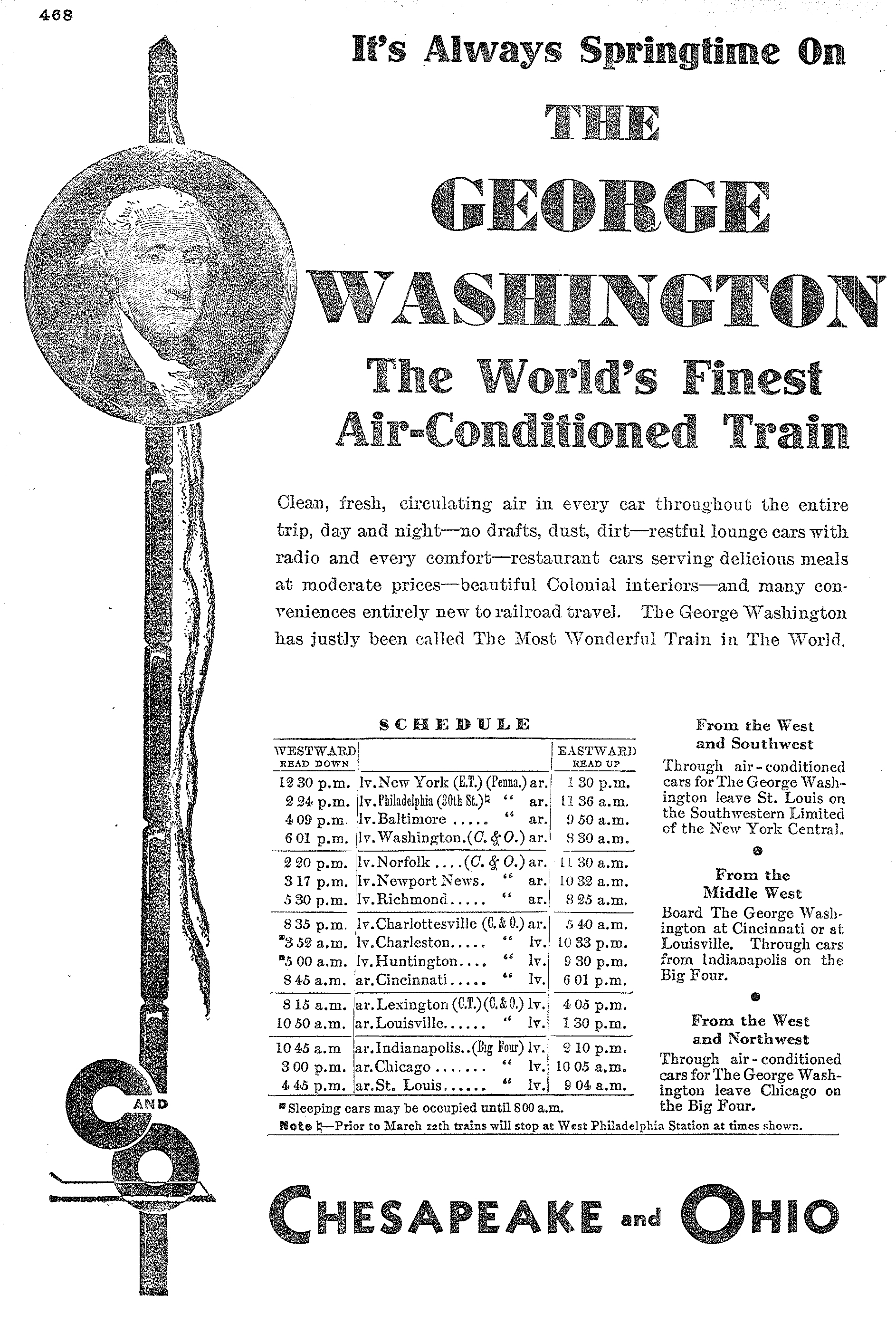
Chessie’s celebrity status did not end with merchandise and an advertising campaign; the kitten became synonymous with the C&O. She earned renewed famed in 1972 when the Chessie System was unveiled, a holding company for the C&O, B&O, and Western Maryland.
The railroad's new paint scheme featured the kitten’s silhouette overlaid in the Chessie System "C." The livery was a mix of vermilion, yellow, and blue.
Timetable (April 30, 1967)
| Time/Leave (Train #1/Chesapeake & Ohio) | Milepost | Location | Time/Arrive (Train #2/Chesapeake & Ohio) |
|---|---|---|---|
| 4:35 PM (Dp) | 0.0 | 8:40 AM (Ar) | |
| 4:52 PM | 8 | 8:05 AM | |
| F 6:14 PM | 85 | F 6:40 AM | |
| F 6:24 PM | 94 | F 6:28 AM | |
| 6:51 PM (Ar) 7:14 PM (Dp) | 115 | 6:05 AM (Dp) 5:35 AM (Ar) | |
| 7:59 PM | 141 | 4:51 AM | |
| 8:23 PM | 154 | 4:30 AM | |
| 9:42 PM | 210 | 3:13 AM | |
| 10:02 PM | 223 | ||
| 10:42 PM | 245 | 2:08 AM | |
| F 11:18 PM | 269 | ||
| 11:54 PM | 290 | 1:06 AM | |
| 12:26 AM | 313 | 12:27 AM | |
| 12:45 AM | 324 | 12:08 AM | |
| 1:41 AM | 361 | 11:16 PM | |
| 2:30 AM | 387 | 10:43 PM | |
| 3:28 AM (Ar), 3:45 AM (Dp) | 437 | 9:40 PM (Dp), 9:27 PM (Ar) | |
| 4:11 AM (Ar), 4:31 AM (Dp) | 453 | 9:04 PM (Dp), 8:49 PM (Ar) | |
| 5:09 AM | 484 | 8:11 PM | |
| F 5:29 AM | 505 | F 7:41 PM | |
| 6:04 AM | 535 | 7:13 PM | |
| 6:23 AM | 552 | F 6:53 PM | |
| 7:09 AM | 594 | 6:15 PM | |
| 7:40 AM (Ar) | 599 | 6:00 PM (Dp) | |
| Time/Leave (Train #1/Baltimore & Ohio) | Milepost | Location | Time/Arrive (Train #2/Baltimore & Ohio) |
| 8:20 AM (Dp) | 599 | 5:15 PM (Ar) | |
| F 8:49 AM | 621 | F 4:40 PM | |
| 9:50 AM | 671 | 3:40 PM | |
| 9:04 AM | 686 | 2:18 PM | |
| 9:51 AM | 725 | 1:34 PM | |
| 10:43 AM | 768 | 12:47 PM | |
| 11:02 AM | 787 | 12:18 PM | |
| 11:16 AM | 797 | 12:05 PM | |
| 11:45 AM | 819 | 11:45 AM | |
| 12:17 PM | 841 | 11:20 AM | |
| 12:45 PM | 866 | 10:54 AM | |
| F 2:00 PM | 934 | 9:45 AM | |
| 2:30 PM | 937 | 9:30 AM |
The stateliness of the original George Washington, along with its spectacular scenery through western Virginia's Blue Ridge, West Virginia's New River George, and portions of Kentucky soon transformed the train's into C&O’s flagship.
Its popularity even surpassed the railroad’s top service of the period, the Fast Flying Virginian. Its popularity also stemmed from the many online resort hotels, most notably the "Greenbrier" in White Sulphur Springs, West Virginia.
Consist (1952)
Listed as trains #1 (westbound) and #2 (eastbound) the train could reach New York City, via the Pennsylvania Railroad and
available Pullman/sleeper service, or St. Louis, via the Baltimore &
Ohio.
In the early 1950s it was updated with lightweight, streamlined equipment including matching EMD E-series diesels, adorned in a beautiful livery of blue, yellow, and gray.
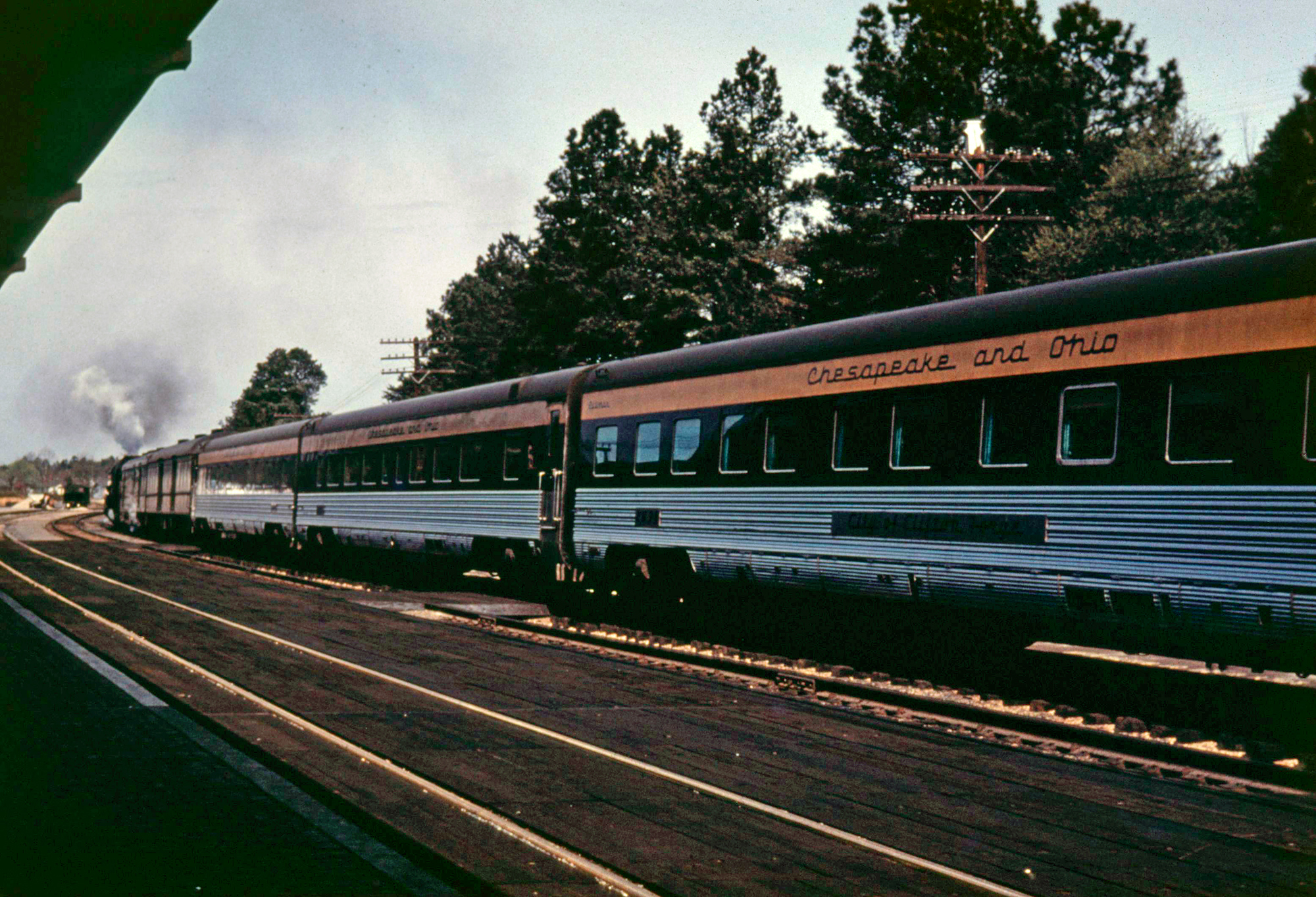 Chesapeake & Ohio's Newport News section of the "George Washington" departs westbound from Williamsburg, Virginia during a summer's morning in the early 1950's. Nearest the photographer is one of C&O's 10 roomette/6 double-bedroom Pullmans, the "City of Clifton Forge." Author's collection.
Chesapeake & Ohio's Newport News section of the "George Washington" departs westbound from Williamsburg, Virginia during a summer's morning in the early 1950's. Nearest the photographer is one of C&O's 10 roomette/6 double-bedroom Pullmans, the "City of Clifton Forge." Author's collection.Final Years
The George Washington's consist included Pullman service sleepers, a slumber-room coach, reclining seat coaches, a diner-lounge, and sometimes a coffee shop car.
According to Mr. Dixon's book, in the summer of 1963 the C&O, having gained control of the Baltimore & Ohio, transferred a slumbercoach, sleeper, and standard coach from the B&O's National Limited (Baltimore/Washington - St. Louis) to George Washington.
This was move was temporary due to the B&O's major daylightling project ongoing along the Parkersburg Branch section (Clarksburg - Parkersburg) of its St. Louis main line at the time. This arrangement, however, was later made permanent in both directions in 1965. The George Washington remained in service lasted until the end, when Amtrak took over most intercity passenger services on May 1, 1971.
Sources
- Dixon, Thomas W. Chesapeake And Ohio Railway: A Concise History And Fact Book. Clifton Forge: Chesapeake & Ohio Historical Society, 2012.
- Dixon, Thomas W. Chesapeake & Ohio K-4 Class 2-8-4 Steam Locomotives. Clifton Forge: Chesapeake & Ohio Historical Society, 2013.
- Dixon, Thomas W. Chesapeake & Ohio Passenger Service: 1847-1971. Clifton Forge: Chesapeake & Ohio Historical Society, 2013.
- Schafer, Mike and Welsh, Joe. Streamliners, History of a Railroad Icon. St. Paul: MBI Publishing, 2003.
Contents
Recent Articles
-
Washington Thomas The Train Rides
Dec 21, 25 04:57 PM
This article will take you on a detailed journey through A Day Out With Thomas events held in Washington, offering insights into what makes this experience extraordinary for families and railroad enth… -
Pennsylvania Thomas The Train Rides
Dec 21, 25 03:52 PM
"A Day Out With Thomas” train rides offer a unique opportunity for children and their families to engage in a magical and memorable experience, setting the stage for a full day of fun and adventure. -
Illinois Thomas The Train Rides
Dec 21, 25 12:30 PM
In Illinois, the "A Day Out With Thomas" event offers a unique chance for families to immerse themselves in the enchanting world of Thomas and friends, creating memories that last a lifetime.

